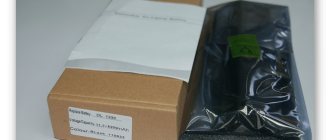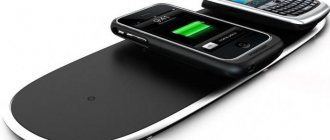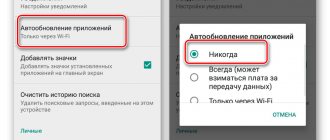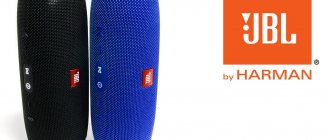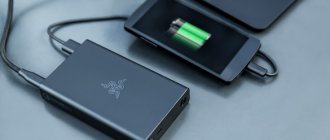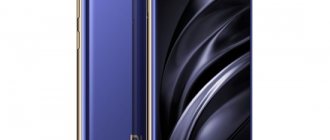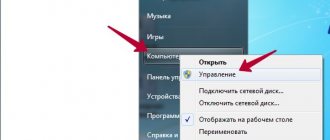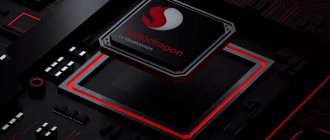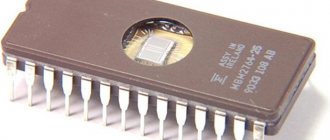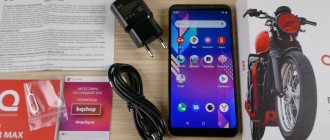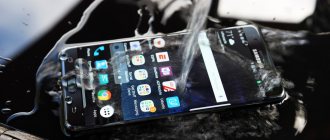How does fast charging work in principle?
Conventional chargers or a USB port are capable of supplying the device with a voltage of 5V with a current of 0.5 to 2.5A . Under such conditions, modern smartphones and tablets take a very long time to charge: from several hours or even overnight.
Fast charging is characterized by increased current and voltage. In different standards, these values can reach up to 20V and 5A .
In addition, there is feedback from the battery, allowing the adapter to flexibly change charge parameters.
For fast charging, you need both support for the standard on the part of the gadget and an appropriate charger. If there is a mismatch, fast charging simply will not occur, charging the consumer in the usual slow way.
For example, Quick Charge uses the INOV (Intelligent Negotiation for Optimum Voltage) mode, which uses signals from the battery to determine the optimal voltage for charging.
A completely discharged battery (or close to such a state) can be safely charged at high voltage, “filling” half the capacity in record minutes, and closer to the end of charging, you need to reduce the voltage so as not to overcharge and damage the battery.
That is why all manufacturers of fast charging technology like to boast about the first fast charge cycle , reporting that 40-60% will be replenished in 30-60 minutes.
Almost everyone equips their manufactured devices with a “unique” standard, tying the buyer to accessories of their own production.
Here are the most common ones.
Comparison of fast charging standards 2020 (list)
Apple Fast Charging
Official page
- • voltage - 14.5V;
- • current strength - 2A;
- • power - 29W;
- • speed - from 0% to 50% in 30 minutes with USB-PD charging;
- • limitations - after 79% normal charging occurs.
Pros:
- + uses USB-PD,
- + is actively developing and growing in popularity,
- + a standard that is supported by all manufacturers in the industry.
Minuses:
- — you need to buy a Lightning-USB-C cable with USB-PD support,
- — Apple does not include compatible cables and chargers as standard.
Which devices and phones support Apple fast charging?
- • iPhone XS and XS Max
- • iPhone XR
- •iPhone X
- • iPhone 8 and 8 Plus
- • iPad Pro
- • MacBook 12
Which charger should I buy for Apple fast charging?
- • Apple USB power adapter with 21W, 61W or 87W power.
- • A third-party USB-C adapter of comparable power with USB-PD support.
Fast charging Qualcomm Quick Charge
Official page
Quick Charge 1.0
- • voltage - 5V;
- • current strength - 2A;
- • power - 10W;
- • speed - practically no different from other solutions of 2013 (the moment of release);
- • limitations - standard only for Snapdragon 600, but never spread.
Quick Charge 2.0
- • voltage - 5V/9V/12V;
- • current strength - 1.67/2A;
- • power - 18W;
- • speed - speeds up to 75%, but depends on the device and combination of charging parameters;
- • limitations - it is believed that the worst effect on the “health” of the battery is when filled to 100% due to high temperatures.
Quick Charge 3.0
- • voltage - changes 3.6V-20V in 0.2V steps (intelligent matching INOV 1.0/2.0);
- • current strength - 2.5A/4.6A;
- • power - 18W;
- • speed - charges in 30 minutes from 0% to 50%;
- • limitations - absolutely incompatible with USB-PD, risk when working with USB Type-C with a high load.
Quick Charge 4.0/4.0+
- • voltage - 5V/9V (USB-PD) or varies 3.6V-20V in steps of 0.2V (INOV 3.0);
- • current — 3A (USB-PD) or 2.5A/4.6A;
- • power — 27W (maximum for USB-PD);
- • speed - charges in 15 minutes from 0% to 50% (during tests ~1 hour for a 2700 mAh battery);
- • restrictions - risk of overheating and short circuit, for which a safety system with sensors is used.
Pros:
- + USB-PD support in QC4+,
- + the most widely used standard,
- + backwards compatible with older versions of the standard,
- + provides additional protection for the battery and electronic components.
Minuses:
- — becomes outdated relatively quickly and has limitations in previous versions,
- — QC4+ support is still rare.
Which devices and phones support Qualcomm Quick Charge?
- • always up-to-date official list in PDF format.
Which charger should I buy for Quick Charge?
- • Any high-quality adapter supporting QC2.0 and higher.
Samsung Adaptive Fast Charging
Official page
- • voltage - 5V/9V;
- • current strength - 2A;
- • power - 18W;
- • speed - from 0% to 100% about 2 hours on Galaxy S8 (3000 mAh);
- • limitations - Adaptive Fast Charging (9V/2A) requires a proprietary adapter.
Pros:
- + available in all Samsung devices,
- + compatible with Qualcomm Quick Charge 2.0 adapters,
- + the most battery-friendly (due to low temperature) technology.
Minuses:
- - Quick Charge 2.0 chargers are slower than branded chargers,
- - high cost of a branded adapter.
Which devices and phones support Samsung fast charging?
- • all mobile devices of the Samsung Galaxy brand.
Which charger should I buy for Samsung fast charging?
- • Samsung Adaptive Fast Charging adapter.
- • Any high-quality adapter supporting QC2.0 and higher.
Fast charging Motorola TurboPower (Lenovo)
Official page
TurboPower 15
- • voltage - 9V/12V;
- • current strength - 1.2A/1.67A;
- • power — 15W;
- • speed - from 0% to 100% in 90 minutes for Motorola Moto Z;
- • limitations - does not provide full power on new Lenovo and Motorola smartphones.
TurboPower 25
- • voltage - 5V/9V/12V;
- • current strength - 2.15A/2.85A;
- • power — 25W;
- • speed - no official data and expert measurements;
- • restrictions - not identified.
TurboPower 30
- • voltage - 5V;
- • current strength - 5.7A;
- • power — 28.5 W;
- • speed - charging for 15 hours of autonomy in 15 minutes (in fact, the same 90 minutes to 100% on Moto Z);
- • restrictions - not identified.
Pros:
- + available in all Motorola devices,
- + technology is used in the power adapter, controller, battery and software,
- + compatible with all Qualcomm Quick Charge 2.0 chargers and higher.
Minuses:
- — compared to others, charging is slower.
Which devices and phones support Motorola TurboPower fast charging?
- • All models under the Motorola brand.
- • Some Lenovo branded models.
Which charger should I buy for Motorola fast charging?
- • Original Lenovo power adapter.
- • Motorola TurboPower 30 charger.
- • Any high-quality adapter supporting QC2.0 and higher.
Fast charging Mediatek Pump Express
Official page
MediaTek Pump Express
- • voltage - 3.6V-5V;
- • current strength - 3A/4.5A and above;
- • power — 5W(1.2A)/7.5W(1.5A)/10W(2.0A);
- • speed - from 0% to 75% in 30 minutes;
- • restrictions - almost never found on the market (write in the comments if you know something about this).
MediaTek Pump Express Plus (Pump Express+)
- • voltage - 5V-7V,9V,12V;
- • current strength - more than 3A;
- • power - 15W (9V/1.67A) and 24W (12V/2A);
- • speed - from 0% to 75% in 30 minutes;
- • restrictions - used in old or budget devices, found in new cheap Chinese smartphones or models of localized brands.
,
MediaTek Pump Express 2.0+ (Plus)
- • voltage - 5V-20V in 0.5V increments;
- • current strength - 3A/4.5A and above;
- • power — 15W;
- • speed - from 0% to 75% in 30 minutes;
- • limitations - used mainly on inexpensive budget class models.
MediaTek Pump Express 3.0
- • voltage - 3V-6V in increments of 0.01-0.02V;
- • current strength - 5A and above;
- • power — 25W/30W;
- • speed - from 0% to 75% in 20 minutes in stages in three modes: Regular, Turbo 1 and Turbo 2;
- • restrictions - used in expensive devices with USB-C of the previous generation.
MediaTek Pump Express 4.0
- • voltage - 3V-6V in increments of 0.01-0.02V;
- • current strength - up to 5A;
- • power — 25W/30W;
- • speed - from 0% to 75% in 30 minutes;
- • restrictions - charges the battery directly, bypassing its controller (temperature control and charging mode are performed in the charger), used in the best expensive devices with USB Type-C connectors (designated: Pump Express 4.0-enabled).
Pros:
- + adds fast charging in budget devices,
- + compatible with Qualcomm Quick Charge 2.0 adapters,
- + one of the safest technologies in terms of overheating and short circuit control thanks to the Richtek System-On-Chip mechanism.
Minuses:
- — relatively slow charging;
- - used mainly in devices with MediaTek chipset.
Which devices and phones are compatible/support MediaTek fast charging?
- • the vast majority of smartphones and tablets are based on this chipset.
Which charger should I buy for MediaTek fast charging?
- • For Pump Express 4.0 - any adapter with USB-PD support and voltage 3-6V/5A+.
- • For Pump Express 3.0 - any adapter with USB-PD support and voltage 3-6V/5A+.
- • For Pump Express 2.0+ - any adapter that supports Qualcomm Quick Charge 2.0 and higher.
- • For Pump Express Plus - any adapter with a voltage of 5V with or without support for Pump Express Plus, compatible with any USB cable 1.5A and higher, backward compatible with USB BC1.2, Type C, PD2.0 YDT1591 and other traditional chargers.
- • MediaTek chargers are certified - third-party manufacturers are not allowed to produce their own adapters with Pump Express.
Fast charging OnePlus and Oppo Vooc
Official page
OnePlus Dash Charge (License based on Oppo Vooc)
- • voltage - 5V;
- • current strength - 4A;
- • power - 20W;
- • speed - from 0% to 60% in 30 minutes;
- • limitations - requires special Dash Charge cables (they are thicker) for OnePlus devices, does not work with external batteries without Dash Charge certification.
Oppo Vooc
- • voltage - 5V;
- • current strength - 5A;
- • power — 25W;
- • speed - from 0% to 75% in 30 minutes;
- • limitations - like Dash Charge, it requires similar thick cables and an original charger.
Pros:
- + the fastest charging available (about 10 minutes ahead),
- + powerful and expensive power adapters, as well as special cables are always included in the kit,
- + lowest temperature /blog/360_peregrev-smartphona recharging among other technologies.
Minuses:
- — closedness — a complex system of licensing and patents,
- - no compatibility with USB-PD,
- — works only with Vooc and Dash Charge external batteries,
- - Only the original thick power cable is suitable.
Which devices and phones support Vooc fast charging?
- • OnePlus smartphone line.
- • Most Oppo devices have Vooc fast charging features.
Which charger should I buy for fast charging Dash Charge and Vooc?
- • Exclusively branded DC power adapter.
Fast charging Huawei SuperCharge
Official page
- • voltage - 4.5V/5V;
- • current strength - 4.5A/5A;
- • power — 25W;
- • speed - from 0% to 100% about 1 hour 10 minutes on Huawei Mate 20 Pro (4200 mAh);
- • restrictions - not used on all Huawei smartphones.
Pros:
- + USB-PD compatible,
- + works with Quick Charge 2.0 adapters and higher,
- + expensive adapter and cables are always included in the purchase kit,
- + Huawei tests fast charging reliability for a year with 10 tests for overheating, short circuits and extreme environmental conditions.
Minuses:
- - less fast compared to other technologies,
- — for SuperCharge to work 100%, only branded adapters and power banks are required.
Which devices and phones support Super Charge?
• Always up-to-date list of Huawei flagship solutions on this page.
Which charger should I buy for Huawei fast charging?
- • Branded Huawei SuperCharge adapter.
- • Any high-quality adapter supporting QC2.0 and higher.
Quick Charge
At the moment, this is the most common fast charging standard from Qualcomm . It is supported by most Android smartphones with modern Snapdragon processors.
The first generation was released back in 2013. Since then, the technology has gone through three rounds of evolution.
Charging became faster, and the module was supplemented with an increasing number of new chips, not only to speed up the process, but also to increase safety.
Now the output power of some Quick Charges reaches 24W , but most manufacturers limit this figure to 18W.
Thus, the fourth generation Quick Charge in 15-20 minutes .
Power Delivery (USB-PD)
A less common fast charging standard, which is used by Apple in manufactured gadgets.
Fast charging is possible out of the box using Apple 29, 30, 61, or 87 W USB-C power adapters.
In addition, Apple supports third-party accessories certified to the USB Power Delivery (USB-PD) standard.
Fast charging supported on iPhone 8/8 Plus//X R
/Xs/Xs Max.
For example, when using a compatible charger, you can charge your iPhone 8 to 50% in 30 minutes .
USB charger types
As defined by the USB Implementers Forum, there are four types of USB chargers . Depending on the version and plug, the user has the following fast charging options.
USB 1.0
- • voltage - 5V;
- • current - 0.5A;
- • maximum power - 2.5W.
USB 2.0
- • voltage - 5V;
- • current - 0.5A;
- • maximum power - 2.5W.
USB 1.0 and USB 2.0 specifications provide basic charging speeds for any phone and by default require the least amount of power among other standards. But, for example, in an iPhone via a USB connector, charging occurs at an increased current of 2A and a voltage of 5V, which ultimately still gives a modest 10 W of power - four times less than that of a 40-W incandescent lamp from the entrance.
USB 3.0
- • voltage - 5V;
- • current - 0.5A/0.9A;
- • maximum power - 4.5W.
When using a USB 3.0 connector, the voltage will be the same, but the current can be increased to 0.9A.
USB 3.1 (USB-C + USB-PD)
- • voltage - 5-20V;
- • current - 0.5A/0.9A/1.5A/3A/5A;
- • maximum power - 100W.
USB Type-C (USB-C) is an oval-shaped plug with a reversible key (can be connected on either side). The technology can work with both USB 2.0 and the new USB 3.1. Manufacturers choose the latter due to its higher voltage and current potential.
USB Power Delivery (USB-PD) - Many devices feature a more robust standard specification for powering battery power through cables and connectors. The maximum output power in this case is 20V/5A (100W). This option is not suitable for smartphones (in most cases, 3A is enough for them), but is ideal for laptops and large tablets with USB-C.
Additionally, you should take into account the Battery Charging Specification parameter - the battery charging specification, which determines the power consumed by the phone from the USB port. In the latest Battery Charging Rev 1.2 (BC1.2), it takes into account three power sources:
- • SDP (standard downstream port) - a regular basic connector;
- • CDP (charging downstream port) - charging (provides up to 1.5A);
- • DCP (dedicated charging port) - dedicated (independent).
In most cases, phones and charging adapters comply with the limitations of the USB 2.0 and BC1.2 standards, and charge at the lowest speed by default for full compatibility and safety.
You need to understand that all the above specifications are nothing more than recommendations. To achieve faster charging, manufacturers deviate from these parameters by increasing voltage and current. As a result, the phone fills the battery capacity to 100% much faster. Below we provide a list of all existing technologies.
AFC (Adaptive Fast Charging)
Samsung models . The technology dates back to the Galaxy Note 4 and Galaxy S6.
Chargers supporting this standard can operate in two modes: standard 5V at 2A and fast 9V at 1.67A. This charging technology is compatible with Quick Charge 2.0 from Qualcomm.
Samsung provides the following statistics: when using Adaptive Fast Charging, a 3300 mAh battery is charged up to 60% in 30 minutes , and about 15% can be charged in the standard way during this time.
Which smartphones support this feature?
Fast charging support depends on:
- chipset installed in the device;
- implementation of an advanced power chain.
We recommend: Synchronizing your phone on Android
Compatibility with fast charging technology is established at the stage of creating a single-chip system, for which a separate chip is responsible. For example, a manufacturer installs a Snapdragon 665 with QC 3.0 support in a smartphone, but the device does not support it due to the brand’s reluctance to invest in an advanced power circuit. In the case of proprietary technologies like VOOC, the implementation of the knowledge base depends on design features: installation of special batteries, connector, power adapter.
Sometimes there are exceptions to the rules. The Redmi Note 8 Pro smartphone was launched based on MediaTek G90T but is compatible with Qualcomm's QC 3.0.
Note! Smartphone support for fast charging is indicated in the technical specifications of the device on the official website or box. The technology only works in combination with a proprietary power adapter or a licensed Power Bank.
Pump Express
This fast charging technology is being developed by MediaTek . At the moment, the third generation of Pump Express 3.0 is actively used.
During charging, the power supply actively monitors the battery temperature and changes the operating mode depending on changes in the indicator.
A prerequisite for this type of fast charging is the presence of a MediaTek processor and a Type-C port on board.
One of the supported devices – Meizu Pro 6 can fully charge a 2560 mAh battery in an hour !
AC adapters with fast charging
Chargers can be branded or produced by third-party companies with a license from the manufacturer. Depending on the configuration, adapters are immediately placed in the box with the device.
AC adapters with fast charging.
For Samsung
On the company's official website, a unit with support for Super Fast Charging 2.0, with a power of 45 W, is sold for 3,490 rubles. For this price, the buyer receives a charger and a cable with USB Type-C plugs at both ends.
For Apple
The iPhone 11 Pro and 11 Pro Max come with a fast charger included. Power supplies are sold separately: 18 W for 2,930 rubles, 30 W for 4,550 rubles. Additionally, you will have to purchase a compatible USB-C/Lightning or USB/Lightning cable, which will cost 1,800 rubles.
Fast charging for Apple.
Support for fast charging will mean that the user will spend less time near the outlet, will be able to return to the game faster or run home for 15 minutes and replenish the device’s battery by 30-40%. The damage from the flashlight is minimal, and the built-in power controller saves the user from damage to the device.
TurboPower
The standard is developed and supported by Lenovo , and is currently used in Motorola . It is based on the Quick Charge 2.0 standard with backward compatibility support. The device requires a Snapdragon processor to operate.
TurboPower developers decided to increase the charging power to 25.8W. The charger is capable of delivering from 5 to 12V depending on the charging stage.
80% in 45 minutes using TurboPower charging , and will be fully charged in only 80 minutes.
VOOC Flash Charging/Dash Charge
Chinese electronics manufacturer BBK has developed and implemented its own technology for accelerated battery charging.
It is being implemented in devices under the Oppo under the name VOOC Flash Charging, and in OnePlus the same technology is called Dash Charge.
Charging at a normal voltage of 5V produces power up to 25W. Thus, a 3000 mAh battery is charged to 75% in 30 minutes if the smartphone and power supply support VOOC Flash Charging.
OnePlus devices have a charging power limit of 20W and the need to use the original charging cable.
At the same time, Dash Charge charges a 3000 mAh battery in 30 minutes to 63% .
Possible harm to the smartphone battery
The harm to the battery is minimal, which is facilitated by a controller that detects the temperature of the battery and resets or completely stops the voltage supply at critical temperatures. The loss of battery capacity is about 20% after 800 charging cycles, and the service life is reduced by 10%.
Rapid charging is dangerous if:
- the battery is damaged or defective;
- a replica of the original cable or a “non-original” cord was used - a cable with a smaller cross-section is unable to withstand high voltage, which leads to current surges;
- When charging, the phone is in direct sunlight, near a heater, etc.
Super mCharge
A development with this name was demonstrated last year by Meizu .
The most powerful of all 11V mobile chargers can deliver up to 55W of power. This is comparable to the power supply of some modern laptops.
This charging method imposes severe restrictions on the cable used. Only a special cord with a smart module and additional protection can power the device as quickly as possible.
The creators of the technology claim that a 3000 mAh battery can be fully charged in 20 minutes .
Warp Charge from OnePlus
Development of the OnePlus brand. Such an adapter is capable of delivering as much as 30 W. The large flagship OnePlus 7 Pro charges up to 50% in 20 minutes, and takes an hour to fully charge. The system perfectly monitors battery temperature as well as cable compatibility.
One problem is that OnePlus Warp Charge will never get beyond the limits. But for the car you can find branded cigarette lighter adapters with fast charging support.
And one more nuance will be compatibility exclusively with the OnePlus branded cable. Of course, the manufacturer wants to protect you from a possible fire, but nothing prevents many other manufacturers from allowing the use of third-party quality cables.
